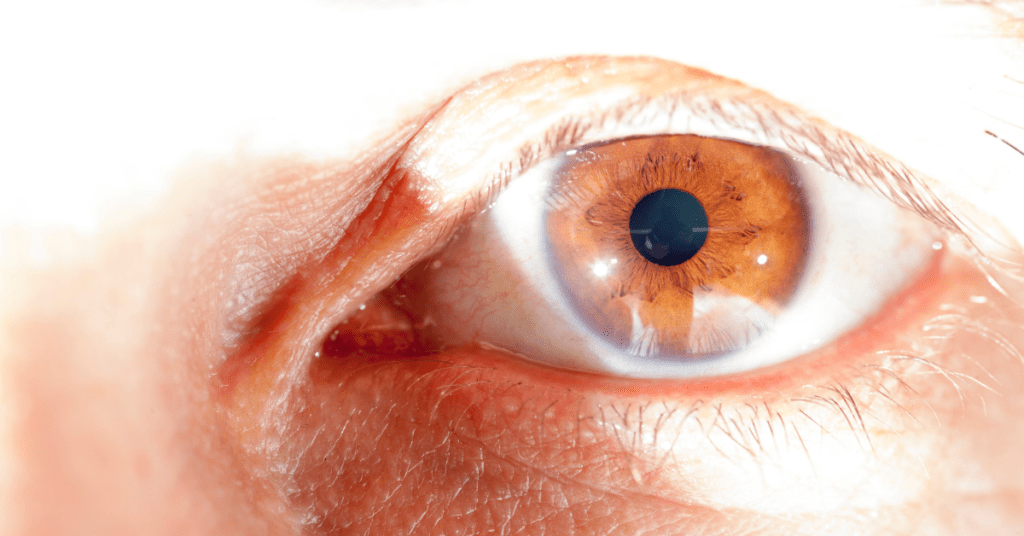Contents
- 1 Diabetes And Eye
- 2 What is Diabetes?
- 3 Anatomy Of Eye
- 4 What Is A Diabetic Eye?
- 5 Diabetes And Eye Disease
- 6 Types Of Diabetic Retinopathy
- 7 Causes Of Diabetic Retinopathy
- 8 Who Is At Risk Of Developing Eye Disease In Diabetes?
- 9 Preventions Of Diabetic Eye/Diabetic Retinopathy
- 10 Treatments Of Diabetic Eye Diseases
- 11 When To Call A Doctor Right Away?
- 12 A Word From MantraCare
Diabetes And Eye
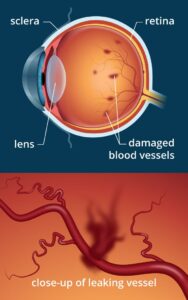
As we know diabetes increases our blood sugar levels. The extra blood glucose can harm the vessels that pass the blood to different parts of the eye, especially the retina. High glucose can also affect fluid levels or cause swelling in the tissue of your eyes. It can lead to blurry vision. Usually, high blood sugar barely causes any fatal eye disease but if the blood sugar is high too often it results in serious eye disorders. High blood sugar can make your vision blurry. In pre-diabetes, many people experience temporary blurred vision. If your diabetes gets unnoticed or your blood sugar fluctuates too often, it can damage the tiny blood vessels present in the back of the eye. Damaged blood vessels may leak fluid and cause swelling.
What is Diabetes?
Diabetes is a disease that affects the metabolism of the body. Diabetes collects the sugar in the blood due to the lack or absence of insulin. Too much glucose in the blood for a long time can harm many parts of the body including internal organs. Diabetes can damage blood vessels, the heart, kidneys, and eyes. It can damage the eyes to an extent that it may lead to blindness. Studies say that about 90% of vision loss from diabetes can be prevented. If you detect it early and take the proper measures, the diseases can be prevented.
People with diabetes should have proper eye checkups regularly to avoid such problems. And if you already have the disorder then there are various treatments that can cure the disorder.
Anatomy Of Eye
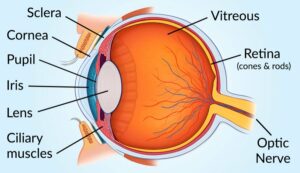 To understand what happens in eye disorders let’s understand how the eye works. The eye has an outer curvy layer called the cornea. The cornea focuses light and protects the eye. The light then travels through aqueous humor which is filled with protective liquid. After that the light meets the iris and then it passes through a lens that performs more focusing. Finally, light travels through the vitreous humor and reaches the back of the eye, the retina.
To understand what happens in eye disorders let’s understand how the eye works. The eye has an outer curvy layer called the cornea. The cornea focuses light and protects the eye. The light then travels through aqueous humor which is filled with protective liquid. After that the light meets the iris and then it passes through a lens that performs more focusing. Finally, light travels through the vitreous humor and reaches the back of the eye, the retina.
The retina records the image focused and it converts those signals into electrical signals and sends them to the brain to understand the image. One part of the retina called the macula is responsible for extra-sharp vision. The macula is nourished by the blood vessels present in and behind the retina.
What Is A Diabetic Eye?
Diabetic eye disease is not the name of one eye problem. Rather, any eye problem caused by diabetes is collectively called diabetic eye disease. These conditions could be blurry vision, cataracts caused by diabetes, diabetic retinopathy, diabetic macular edema, and glaucoma. Diabetes is said to be the prominent cause of blindness in adults.
High blood pressure affects the eye in many ways. Most of the time these conditions do not show any symptoms in the beginning or in the prediabetes stage. In prediabetes, your blood sugar is high, but not high enough to be called diabetes. Some of the eye problems start developing from this stage and may keep developing if the diabetes is not controlled.
A proper eye exam is the only way to diagnose such conditions. It is important to diagnose eye problems as soon as possible before much damage happens.
Diabetes And Eye Disease
If you have diabetes, then you are prone to various eye conditions like-
Blurry Vision
Blurry vision means it gets harder to see fine details in what you are seeing. When you can’t see things clearly it surely decreases the quality of life like you may find it hard to perform some activities like reading, writing, etc.
Blurred vision is probably the first symptom of diabetic eye disease. But it could be a sign of a more serious disease. So if you are experiencing a change in your vision. Go for a full eye examination, it may not be just a change in your eye power but something more serious. You may also experience blurry vision when you start insulin treatment. But the problem resolves within a few weeks.
There is nothing to worry about, as you can correct your vision by bringing your blood sugar level to normal range. You may need 10-12 weeks to get your normal vision back by eating healthy and exercising. Talk to your doctor once about the other measures you need to take.
Cataracts
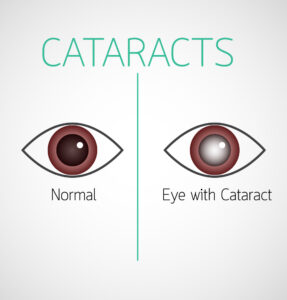
A cataract is the clouding in the lens part of the eye, which leads to blurry vision. Generally, aging is the risk factor for cataracts, but diabetes is also a primary reason for cataracts.
People with diabetes are more prone to cataracts at a younger age and have them progress faster. Cataracts grow with time, so when they are mild you can better your sight with the help of corrective glasses, sunglasses, and anti-glare lenses in your glasses. And when the cataract grows the doctor will suggest surgery to correct your vision. There are many types of surgeries available that remove cataracts easily and replace them with a new clear artificial lens.
Glaucoma
Glaucoma is another complication of diabetes. In glaucoma, the pressure in your eye increases more than normal and damages the optic nerve. The optic nerve sends the electrical signal from the eye to the brain. According to the National Eye Institute, the risk of developing glaucoma is double in people with diabetes than that of other adults. If you have diabetes and are experiencing the following symptoms then you may have glaucoma.
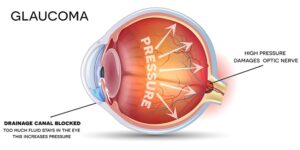
- Peripheral vision loss
- Red eyes
- Halos around lights
- Eye pain (ocular pain)
- Nausea
- Vomiting
If you are experiencing any of these symptoms, you should consult an eye doctor immediately. Glaucoma in diabetes can be treated with sugar control.
Macular Edema
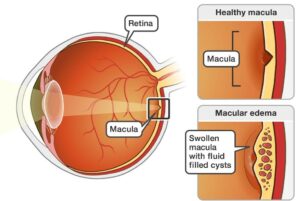
Macular edema is a condition in which the macula swells due to leaking fluids. It usually affects both the eyes. The macula is the part of the retina which helps in performing activities that need extra sharp central vision like reading, driving, and seeing faces. High blood sugar (hyperglycemia) can lead to leaking fluids in the eye causing the swelling of the macula.
The symptoms of macular edema include experiencing changing colors and wavy vision. As the macular edema progresses, it can affect the sharp vision and may even lead to blindness. This disease usually develops in people who have diabetic retinopathy or the symptoms of it.
Diabetic Retinopathy
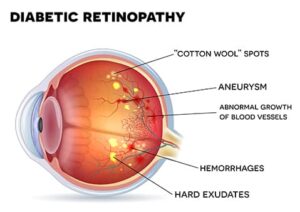
This is a disease of the retina caused by diabetes. Diabetic retinopathy is a common term used for the conditions of the retina. Diabetic retinopathy is the most common type of eye problem seen in people with diabetes. About one in three diabetics who are older than age 40 experiences the symptoms of diabetic retinopathy. If you don’t detect this disease early, there is a chance of going blind. This disease may not show early warning symptoms, that is why it is important for people with diabetes to take a yearly eye examination. And if you feel any discomfort in your vision or eyes, consulting your doctor immediately and starting treating it can lower the risk of any damage.
People with diabetes need to keep tight control of their blood sugar with either medicine like insulin or eating healthy and exercising regularly. If you maintain your blood sugar levels, you are less likely to develop this condition. Other than that you also need to control your blood pressure and cholesterol levels for the best outcomes. It will help in improving your vision and overall health as well.
Types Of Diabetic Retinopathy
There are mainly two types of retinopathy, non-proliferative and proliferative.
Non-proliferative Diabetic Retinopathy
Non-proliferative retinopathy is the most common type of retinopathy in people with diabetes. In this condition, the blood vessels or capillaries present in the retina become blocked. Non-proliferative retinopathy forms bulge in the blood vessels that may leak fluid in the retina. This leakage may lead to swelling of the macula. Although the symptoms in proliferative retinopathy are mild, they may get severe after some time. You are supposed to get the treatment of retinopathy at this stage or it may get way worse.
Proliferative Diabetic Retinopathy
Proliferative diabetic retinopathy is a more advanced form of retinopathy. In this stage, the blood vessels become more damaged that they get blocked. This causes the retina to deprive of oxygen and as a result, new blood vessels may start to grow in the retina and vitreous chamber. These new blood vessels are fragile and can leak blood, leading to blocked vision. If it happens the patient may see dark floaters or streaks. This condition can also cause retinal detachment in which the retina gets distorted.
Causes Of Diabetic Retinopathy
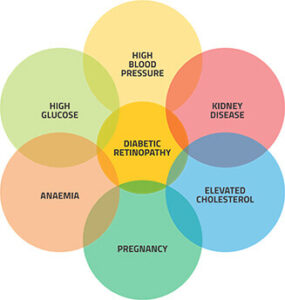
The Cause of diabetic retinopathy is high blood sugar caused due to diabetes. Having too much sugar in your blood can damage your body’s blood vessels, including the eye’s blood vessels. When the sugar is excessive it starts blocking blood vessels. The same thing happens in the eye, the tiny blood vessels in the retina get blocked and leak fluid or even blood. Over time, the retina gets damaged eventually leading to blindness.
Who Is At Risk Of Developing Eye Disease In Diabetes?
There are several factors that influence whether a person may develop diabetic retinopathy. For example-
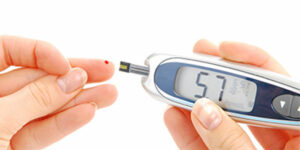
- Blood sugar levels
- Blood pressure levels
- Genetic factors
- How long you have had diabetes
Diabetic eye especially diabetic retinopathy is more likely to develop in people who can not manage to keep their blood sugar normal. Some people are even unaware of their diabetes until it starts showing warning symptoms. Nonproliferative diabetic retinopathy is seen in almost everyone with type 1 diabetes. And most of the people with type 2 diabetes will develop it as wee. However, proliferative diabetic retinopathy which is more dangerous is far less common.
Preventions Of Diabetic Eye/Diabetic Retinopathy
Diabetic eye if not controlled can lead to blindness. If the patient does not follow a healthy diet and starts appropriate exercise, it can be hard to manage blood sugar levels. Along with diabetic retinopathy, it brings many chronic diseases. And if you already have diabetes, it increases the risk of complications of diabetes like eye problems like retinopathy.
But one good news is that Managing blood sugar can treat the conditions and you may live a quality life with just some healthy lifestyle changes like-
Low Carb Diet
You can choose to go on a low-carb diet for managing extra sugar in your blood. Eat high-fiber food like fruits, vegetables, and whole grains for the best results. Eating fiber-rich food helps in decreasing the risk of diabetes and other diseases.
Regular Exercise
Regular intense exercise is the best way to control blood sugar levels. It shapes your body and probably is the best way to keep yourself physically active. Exercises like aerobics, yoga, Zumba, etc. are some of the easiest and effective exercises. And if you can not do such exercises just walking in the morning and evening is enough.
Take Insulin
Taking insulin as prescribed by your doctor can be really helpful. Following doctor’s instructions for your insulin or other diabetes, medicines are necessary for avoiding the complications of diabetes. Also, check your blood sugar levels regularly to help prevent diabetic retinopathy.
Treatments Of Diabetic Eye Diseases
As everyone suggests regular checkups for the eyes, it is very important to keep a check on your sugar level, cholesterol, and blood pressure. This can be the biggest treatment that you can give to your eyes. Once you have inherited these diseases, you should get proper treatment to eradicate all of them.
There are four possible treatments available if you are facing any diabetic eye disease. These treatments are Laser treatment, Anti VEGF Drugs, Vitrectomy. Let us get to the details.
Laser Treatment
The laser treatment is used to destroy the abnormal blood vessels which have grown in the retina. It is a kind of focal treatment given to a patient to prevent vision loss.
Anti-VEGF Drugs
Next is the treatment via Anti-VEGF Drugs. The doctor injects some shots of medicines into the jelly of your eyes, stopping the growth of new blood vessels in the retina. This treatment takes time and you may need to get some regular shots to maintain the results.
Vitrectomy
Diabetic retinopathy is used to treat the late stages of vitrectomy. It is used to treat a detached retina. The doctors suggest this operation so that they can remove the scar tissue, blood, and cloudy fluid from the eye and improve your vision eventually.
When To Call A Doctor Right Away?
Most diabetic eye diseases do not show any warning symptoms. It gets hard to diagnose these conditions. But if you experience any floaters or spots, flashes of light, or it seems like a curtain is pulled over your eyes. These sudden changes in your vision could be a sign of a detached retina. It is a medical emergency that needs immediate attention.
A Word From MantraCare
Do you want to get rid of diabetes? Join our online diabetes consultation program and reverse your Diabetes naturally through lifestyle changes such as a Personalized Diet plan, Exercise, dieticians, and health coaches.
